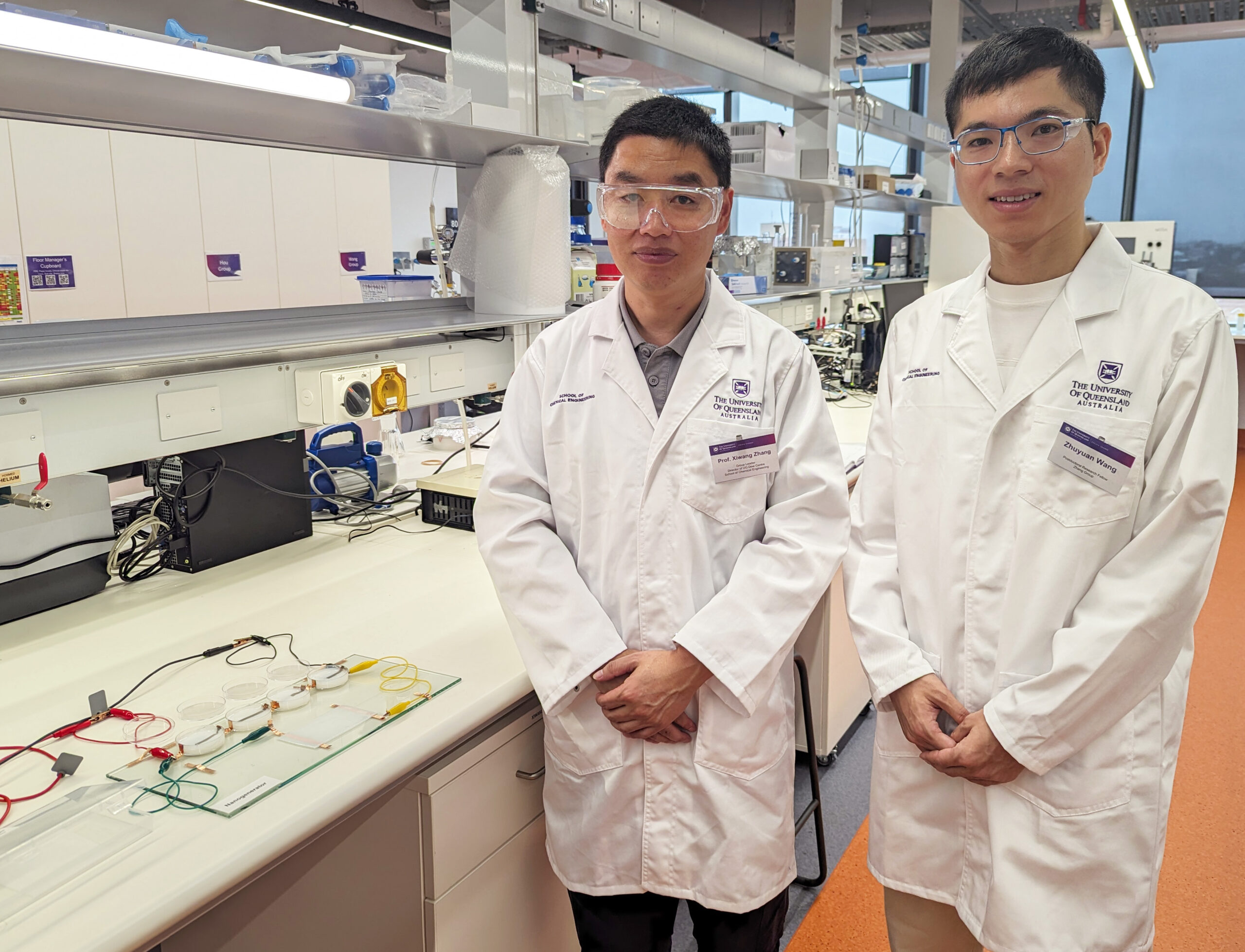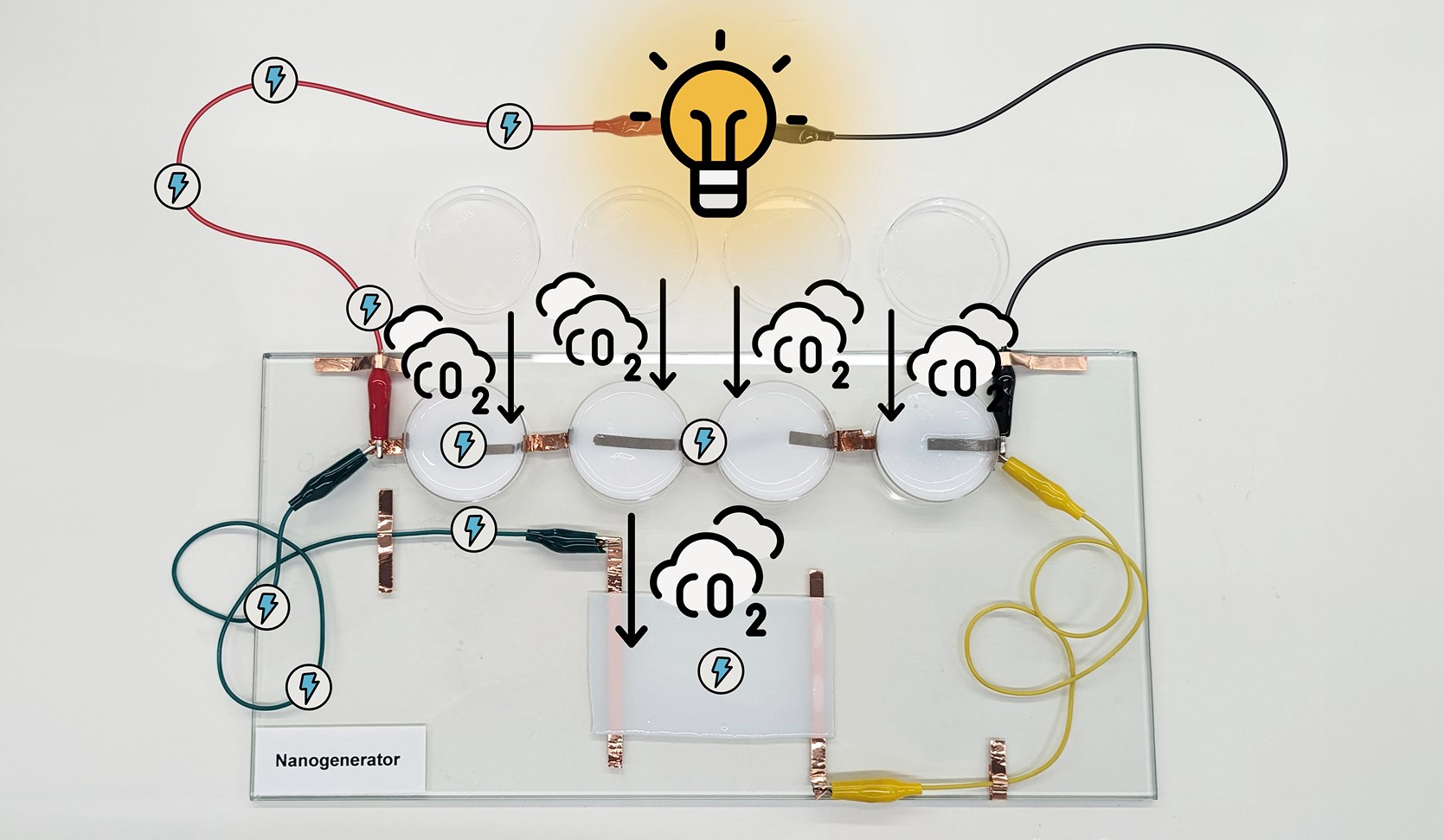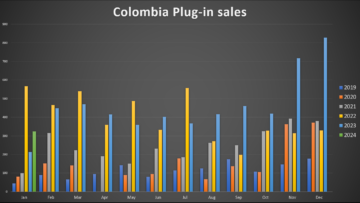Sign up for daily news updates from CleanTechnica on email. Or follow us on Google News!
When I first read about the work of the University of Queensland research team claiming to create electricity from CO2, my initial thought was that this was a cross between a fossil fuel funded beatup and a fairytale. But, digging deeper, and talking with Dr Zhuyuan Wang of UQ’s ARC GETCO2 centre, it appears that it is an idea backed by science and showing some promise for a better future. You can read the press release here and watch a short video here.
Those who are more technically capable than I can check out the full write up in Nature.
So, it is true, “University of Queensland researchers have built a generator that absorbs carbon dioxide (CO2) to make electricity.” It does look too good to be true, but energy is carried by CO2, then gets wasted and released as heat. The UQ research team is working on harvesting a small portion of that energy as electricity. Dr Wang tells me that no external energy is needed to initiate the electricity production in their current prototype. It is spontaneous. He adds that they might need a gas pump to initiate the reaction when they go to a larger scale.

In the current experimentation process, CO2 is used from a gas bottle, but Dr Wang sees a future where CO2 could be captured from the air and used. In this scenario, the generator could be installed in a CO2-intensive environment like a factory. “Perhaps even installed at a coal fired power station, assuming they will still exist when the technology becomes scalable,” I interrupted. Dr Wang suggested that his generator could be installed alongside a carbon capture and storage (CCS) facility to lower the costs associated with CCS.
Dr Wang assures me that the research is not funded by fossil fuel lobby groups. The funding comes from the University of Queensland, Monash University, and the Australian Research Council.
Although the prototype nanogenerator only harvests 1% of the available energy from CO2, the team is working on the possibility of boosting output to 10–20%. At that level of efficiency, Dr Wang believes that this technology will be competitive with wind turbines and solar panels. The next step, he tells me, is to reach 5–10%. I pressed him on a possible timeline, but he replied: “It is hard to predict when this will happen. The team is working on a tenfold increase in performance.”

Dr Zhuyuan Wang, who is based at the Dow Centre for Sustainable Engineering Innovation, hails the breakthrough saying that the small, proof-of-concept nanogenerator is carbon negative. I will let him explain in his own words, as when it comes to science, I am a bear of little brain.
“This nanogenerator is made of two components: a polyamine gel that is already used by industry to absorb CO2 and a skeleton a few atoms thick of boron nitrate that generates positive and negative ions. We’ve worked out how to make the positive ions much larger than the negative ions and because the different sizes move at different speeds, they generate a diffusion current which can be amplified into electricity to power light bulbs or any electronic device.”
In our interview, I queried this and asked for more explanation. He told me that the positive ions are anchored on a larger particle, whilst the negative ion is free. So, when they move, the negative ion can move freely but the positive ions are fixed. A current is generated.
“In nature and in the human body, ion transportation is the most efficient energy conversion — more efficient than electron transportation which is used in the power network.” The two components were embedded in a hydrogel which is 90% water, cut into 4-centimetre discs and small rectangles, and then tested in a sealed box pumped full of CO2.
“When we saw electrical signals coming out, I was very excited but worried I’d made a mistake,” Dr Wang said. “I double-checked everything, and it was working correctly so I started dreaming about changing the world using this technology. This technology goes further than being carbon neutral — it consumes CO2 as it generates energy.”
Professor Xiwang Zhang, Director of the Dow Centre, said the team was looking at potential applications for the nanogenerator in the future. “We could make a slightly bigger device that is portable to generate electricity to power a mobile phone or a laptop computer using CO2 from the atmosphere. A second application on a much larger scale would integrate this technology with an industrial CO2 capture process to harvest electricity.” The ARC Centre of Excellence for Green Electrochemical Transformation of Carbon Dioxide will continue the development of the nanogenerator.
Chip in a few dollars a month to help support independent cleantech coverage that helps to accelerate the cleantech revolution!
“We want to realise the value in a problematic greenhouse gas and to change the perception of CO2,” Professor Zhang said. Not just perception, I hope, but also use! Those who doubt the credentials of these researchers can read their UQ profiles:
Dr. Zhuyuan Wang is a Postdoc Research Officer at UQ Dow Centre in the School of Chemical Engineering. He is an active and frontline researcher in the field of membrane separation with over 6 years of experience. He used to work at a listed membrane manufacturing company in China (2016–2019) focusing on developing Polyamide Thin Film Composite (PA-TFC) for water treatment. He then commenced his Ph.D. research at Monash University (2019–2023, Monash) under the supervision of Prof. Xiwang Zhang and Prof. Huanting Wang.
Zhuyuan is currently interested in developing ion-exchange membranes, especially proton exchange membranes, and in their application around electrolyzers for green hydrogen production and CO2 electrochemical reduction.
Prof. Xiwang Zhang is the Endowed Dow Chair in Sustainable Engineering Innovation at the University of Queensland, Director of UQ Dow Centre, and Director of ARC Centre of Excellence for Electrochemical Transformation of Carbon Dioxide (GetCO2). He was the Founding Director of ARC Industry Transformation Research Hub for Energy-efficient Separation (EESep) and the Deputy Director of Monash Centre for Membrane Innovation (MCMI) at Monash University before he moved to UQ in 2022. Prof. Zhang has more than 15 years of R&D experience in both academia and industry, with demonstrated achievements in technology development and translation. His research focuses on membrane and advanced oxidation technologies for energy-efficient separation, water and wastewater treatment, resource recovery, green chemical synthesis, and renewable energy generation. Prof. Zhang was the recipient of the prestigious ARC Australian Research Fellowship, Future Fellowship, and Monash Larkins Fellowship.
I finished my interview with Dr Wang by asking what was the most important thing he wanted the readers of CleanTechnica to know. “Our ARC GETCO2 centre will remain dedicated to transforming CO2 waste into valuable resources for the future.” A bit like horse manure at the turn of the century, I quipped. In the cities, it is a pollutant, but on a farm, it makes everything grow much better. He agreed.
Have a tip for CleanTechnica? Want to advertise? Want to suggest a guest for our CleanTech Talk podcast? Contact us here.
Latest CleanTechnica.TV Video
[embedded content]
Advertisement
CleanTechnica uses affiliate links. See our policy here.
- SEO Powered Content & PR Distribution. Get Amplified Today.
- PlatoData.Network Vertical Generative Ai. Empower Yourself. Access Here.
- PlatoAiStream. Web3 Intelligence. Knowledge Amplified. Access Here.
- PlatoESG. Carbon, CleanTech, Energy, Environment, Solar, Waste Management. Access Here.
- PlatoHealth. Biotech and Clinical Trials Intelligence. Access Here.
- Source: https://cleantechnica.com/2024/05/02/electricity-from-carbon-dioxide/
- :has
- :is
- :not
- :where
- $UP
- 15 years
- 15%
- 2022
- 400
- 6
- 971
- a
- About
- absorbs
- Academia
- accelerate
- achievements
- active
- Adds
- advanced
- Advertise
- Affiliate
- agreed
- AIR
- alongside
- already
- also
- am
- Amplified
- an
- anchored
- and
- any
- appears
- Application
- applications
- Arc
- ARE
- around
- AS
- asked
- asking
- associated
- assuming
- assures
- At
- Atmosphere
- Australian
- available
- backed
- based
- BE
- Bear
- because
- becomes
- before
- being
- believes
- Better
- between
- bigger
- Bit
- body
- boosting
- both
- Box
- Brain
- breakthrough
- built
- bulbs
- but
- by
- CAN
- capable
- capture
- captured
- carbon
- carbon capture
- carbon dioxide
- carried
- centre
- Century
- Chair
- change
- changing
- check
- chemical
- China
- Cities
- claiming
- cleantech
- Cleantech Talk
- co2
- Coal
- comes
- coming
- commenced
- company
- competitive
- components
- computer
- content
- continue
- Conversion
- correctly
- Costs
- could
- Council
- courtesy
- create
- Credentials
- Cross
- Current
- Currently
- Cut
- dedicated
- deeper
- demonstrated
- deputy
- developing
- Development
- device
- different
- Diffusion
- Director
- does
- dollars
- doubt
- dow
- dr
- efficiency
- efficient
- electricity
- Electronic
- embedded
- energy
- Engineering
- Environment
- especially
- Even
- everything
- Excellence
- exchange
- excited
- exist
- experience
- Explain
- explanation
- external
- Facility
- factory
- farm
- few
- field
- Film
- finished
- fired
- First
- fixed
- focuses
- focusing
- For
- fossil
- Fossil fuel
- founding
- Founding Director
- Free
- freely
- from
- Fuel
- full
- funded
- funding
- further
- future
- GAS
- generate
- generated
- generates
- generation
- generator
- gets
- Go
- Goes
- good
- Green
- greenhouse gas
- Group’s
- Grow
- Guest
- hails
- happen
- Hard
- harvest
- Harvesting
- Have
- he
- helps
- him
- his
- hope
- Horse
- How
- How To
- HTTPS
- Hub
- human
- hydrogen
- i
- idea
- important
- in
- Increase
- independent
- industrial
- industry
- initial
- initiate
- Innovation
- installed
- integrate
- interested
- interrupted
- Interview
- into
- IT
- jpg
- just
- Know
- laptop
- larger
- let
- Level
- light
- like
- links
- Listed
- little
- Lobby
- Look
- looking
- lower
- made
- make
- MAKES
- manufacturing
- max-width
- me
- might
- mistake
- Mobile
- mobile phone
- Month
- more
- more efficient
- most
- move
- moved
- much
- my
- Nature
- Need
- needed
- negative
- network
- Neutral
- New
- news
- next
- no
- of
- Officer
- on
- only
- or
- our
- out
- output
- over
- own
- panels
- particle
- perception
- performance
- phone
- photo
- plato
- Plato Data Intelligence
- PlatoData
- player
- podcast
- policy
- portable
- portion
- positive
- possibility
- possible
- potential
- power
- predict
- press
- Press Release
- prestigious
- process
- Production
- prof
- Professor
- Profiles
- promise
- prototype
- pump
- R&D
- reach
- reaction
- Read
- readers
- recovery
- reduction
- release
- released
- remain
- Renewable
- renewable energy
- replied
- research
- researcher
- researchers
- resource
- Resources
- Said
- saw
- saying
- scalable
- Scale
- scenario
- School
- Science
- Second
- see
- sees
- Short
- showing
- signals
- sizes
- slightly
- small
- So
- solar
- solar panels
- some
- speeds
- started
- station
- Step
- Still
- storage
- suggest
- supervision
- support
- sustainable
- synthesis
- Talk
- talking
- team
- technically
- Technologies
- Technology
- Technology Development
- tells
- tenfold
- tested
- than
- that
- The
- The Future
- the world
- their
- then
- These
- they
- thin
- thing
- this
- those
- thought
- timeline
- tip
- to
- told
- too
- Transformation
- transforming
- Translation
- transportation
- treatment
- true
- TURN
- tv
- two
- under
- university
- Updates
- us
- used
- uses
- using
- Valuable
- value
- very
- Video
- wang
- want
- wanted
- was
- Waste
- wasted
- Watch
- Water
- we
- were
- What
- when
- which
- Whilst
- WHO
- will
- wind
- with
- words
- Work
- worked
- working
- world
- worried
- would
- write
- years
- you
- youtube
- zephyrnet
- zhang










